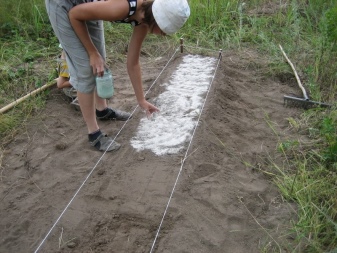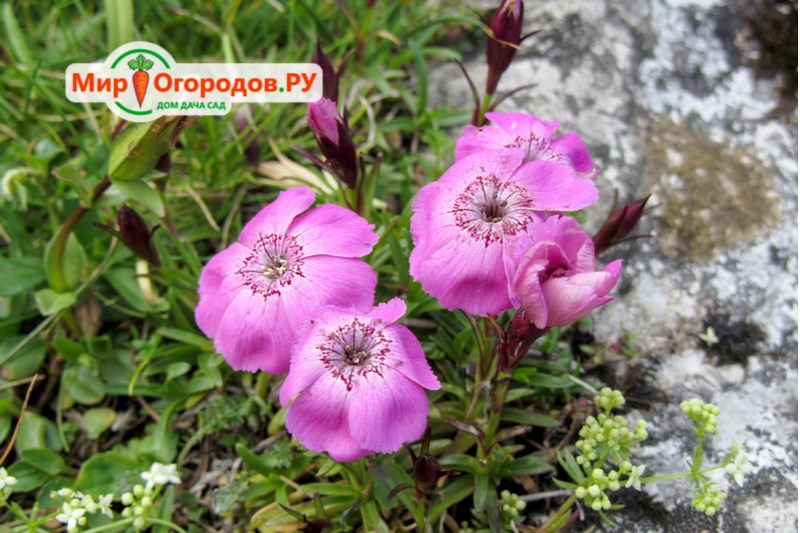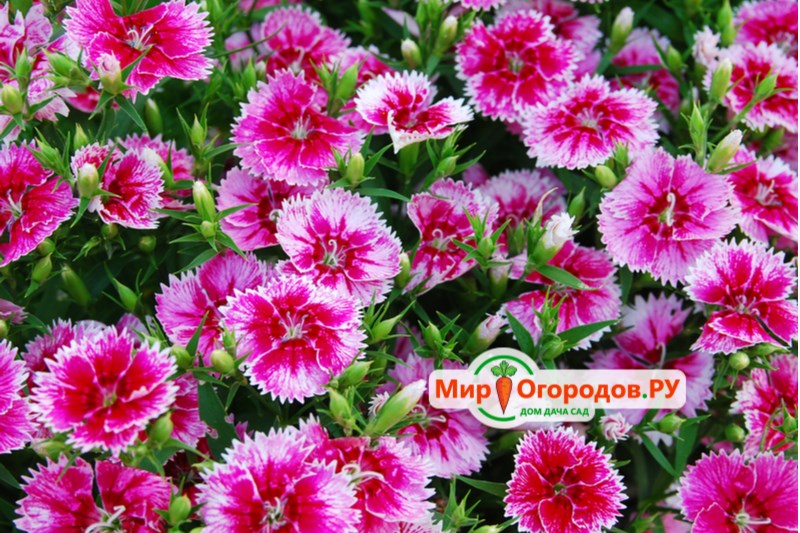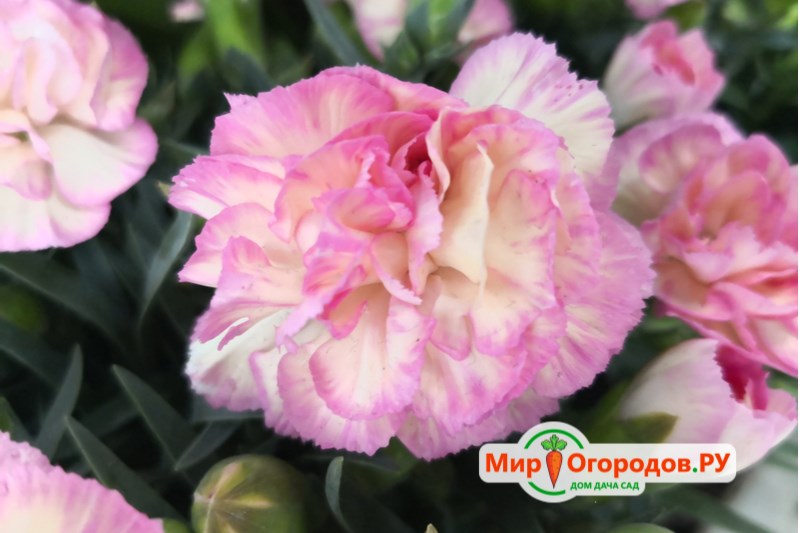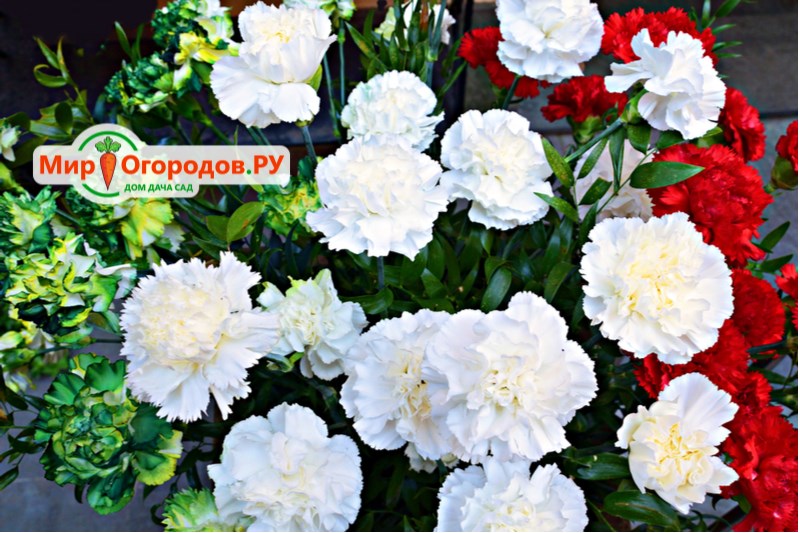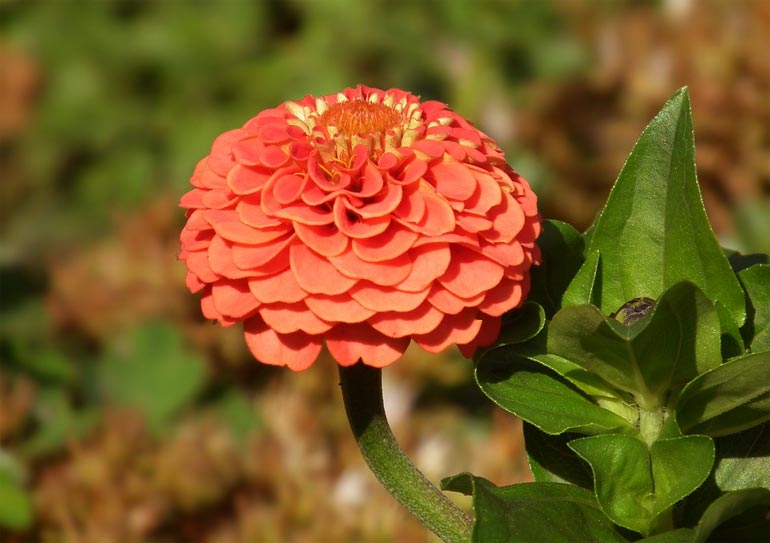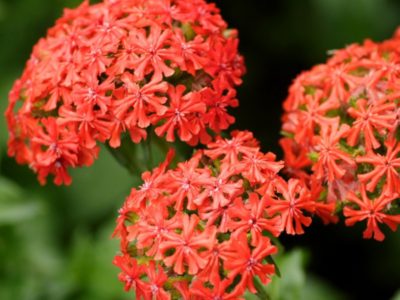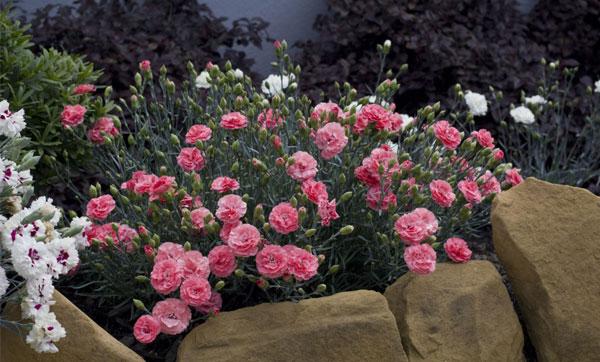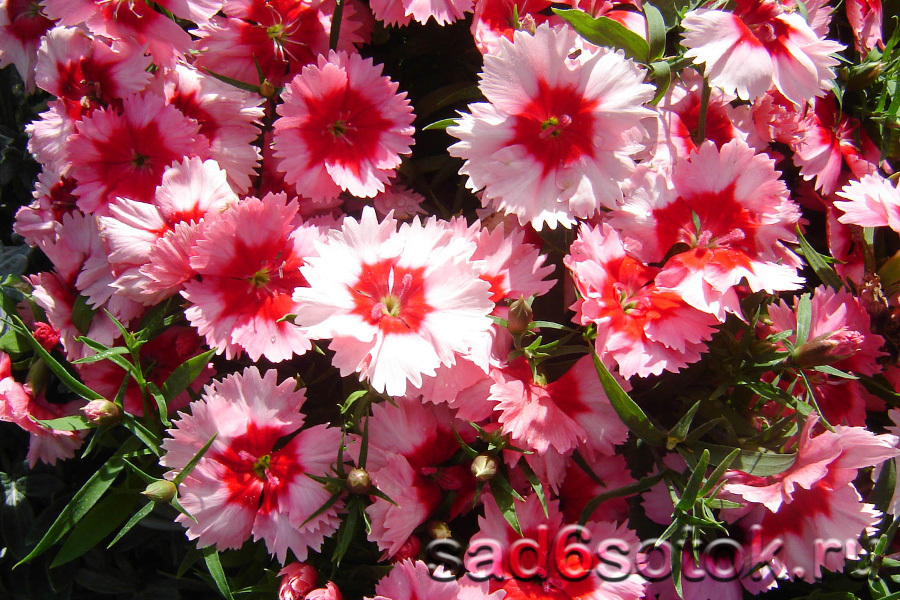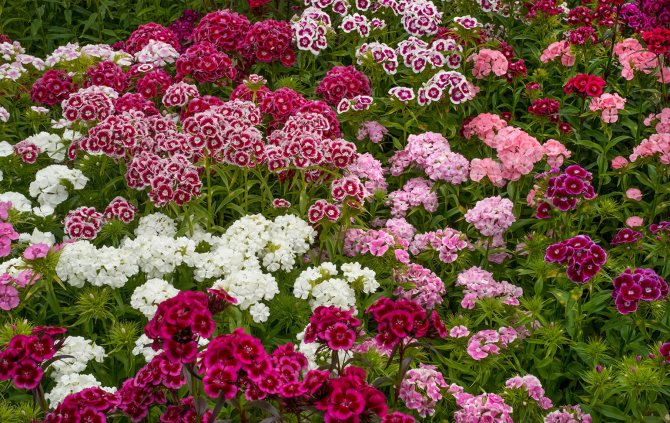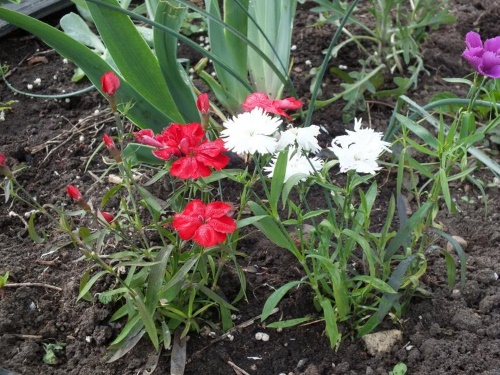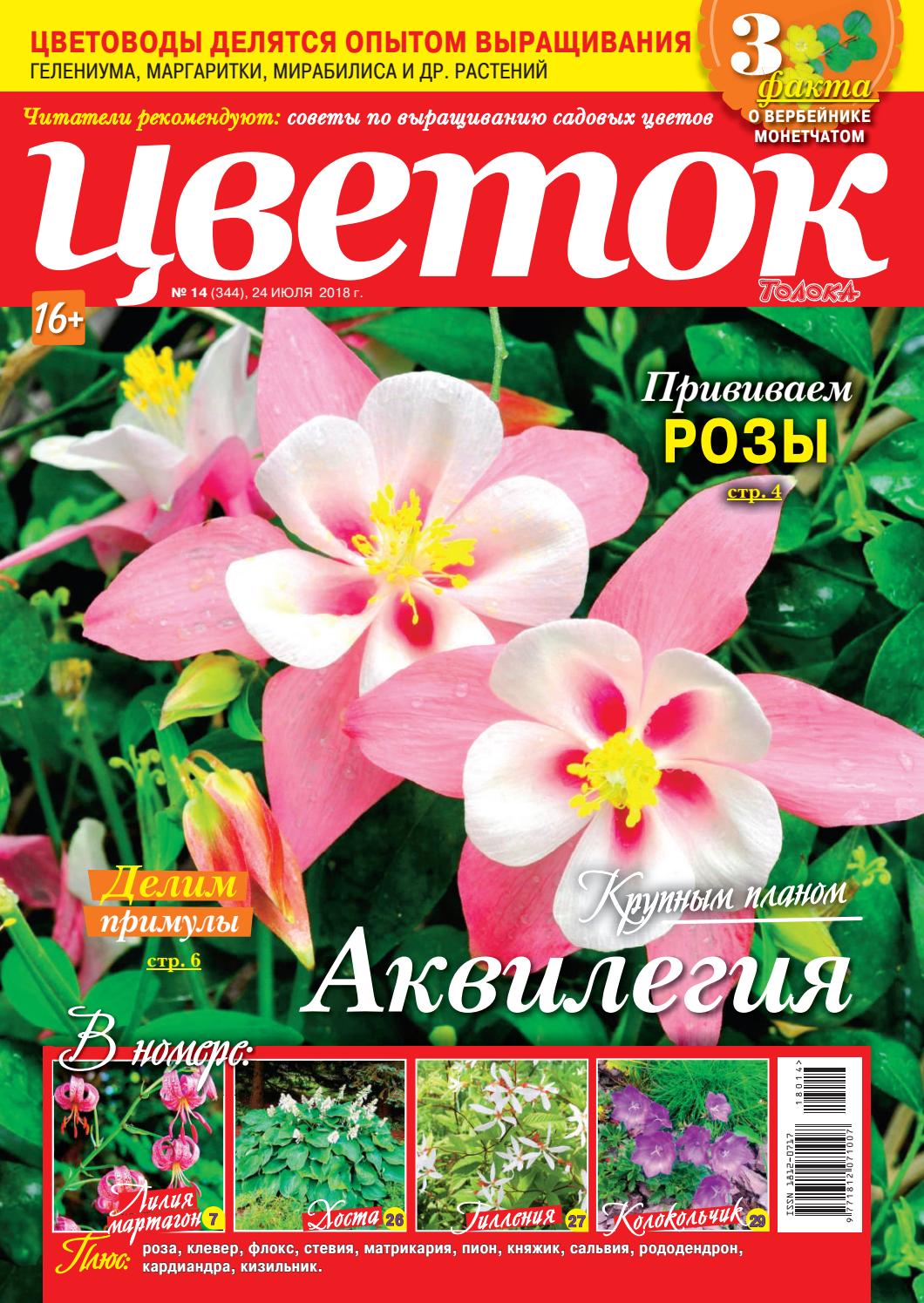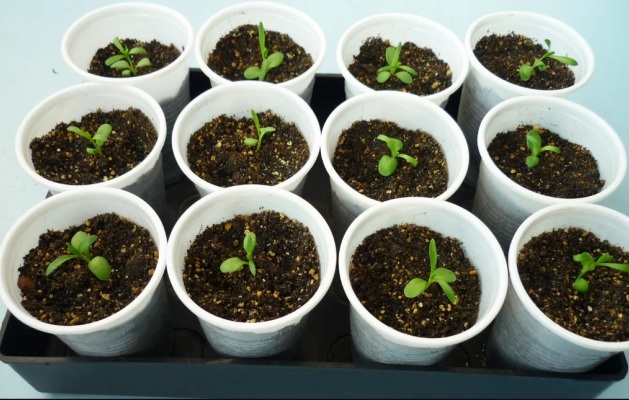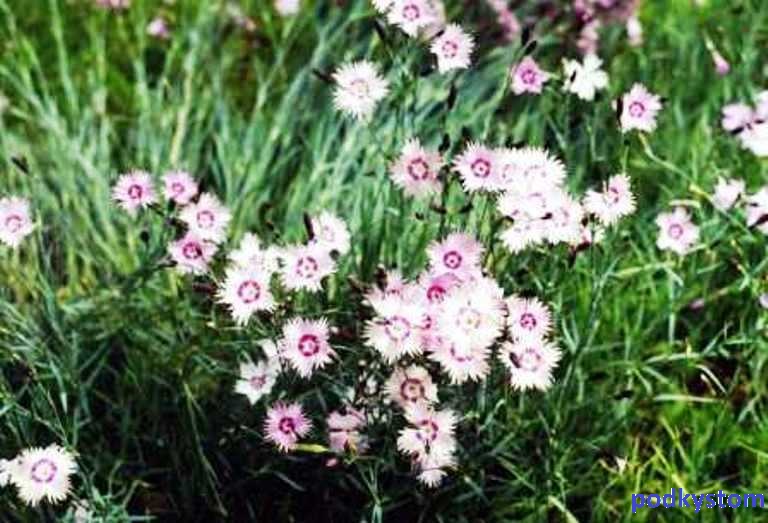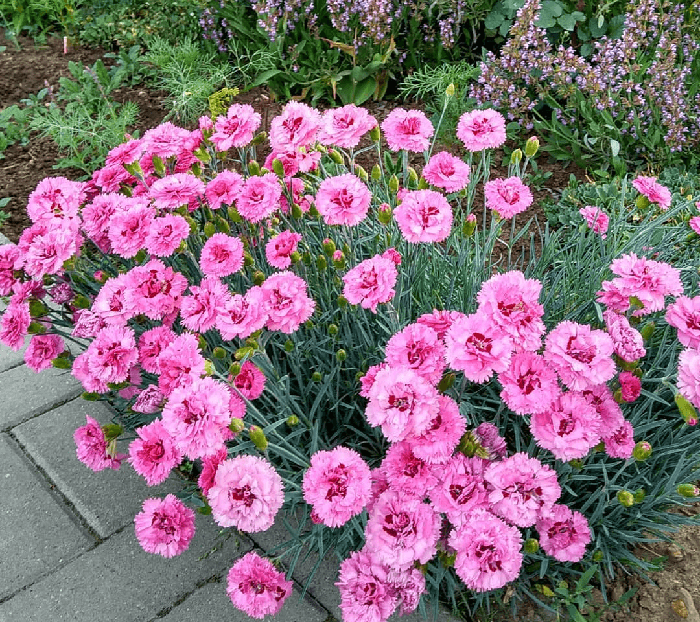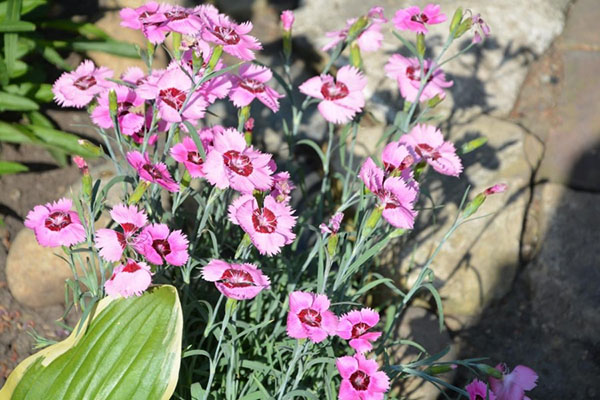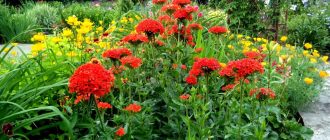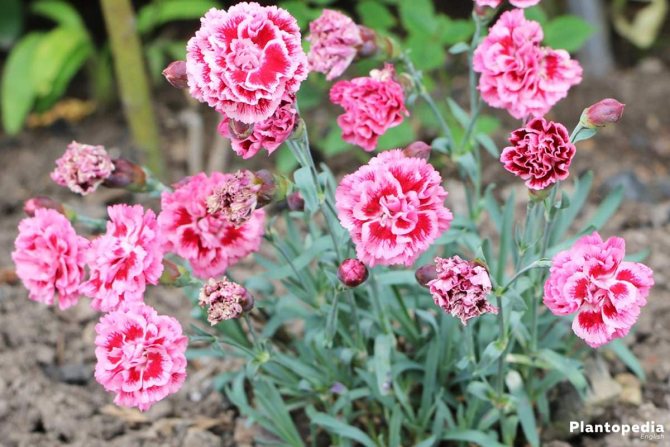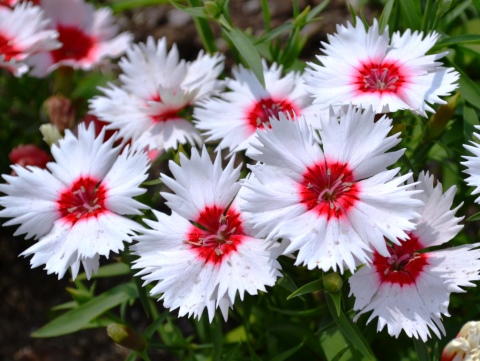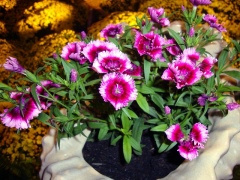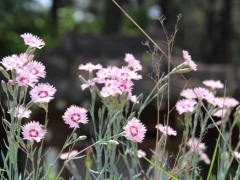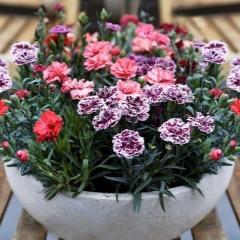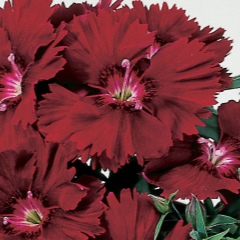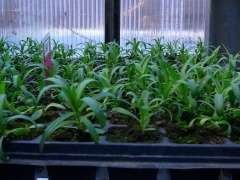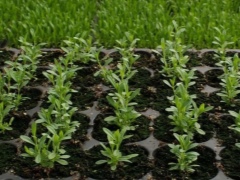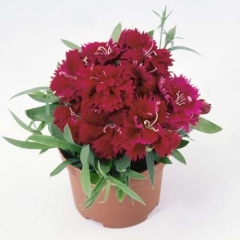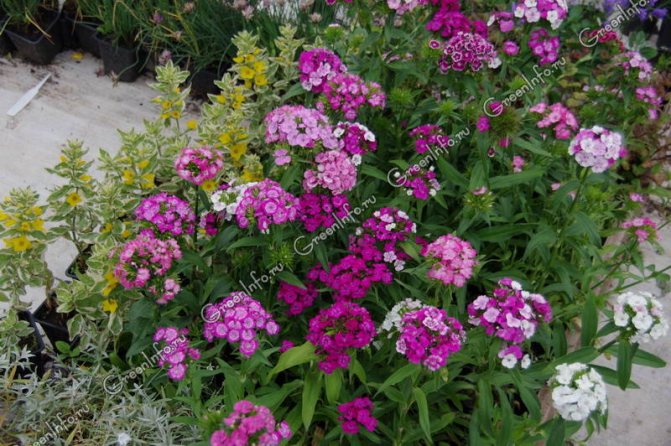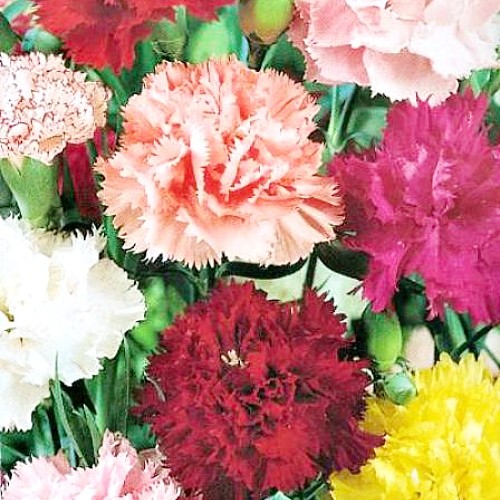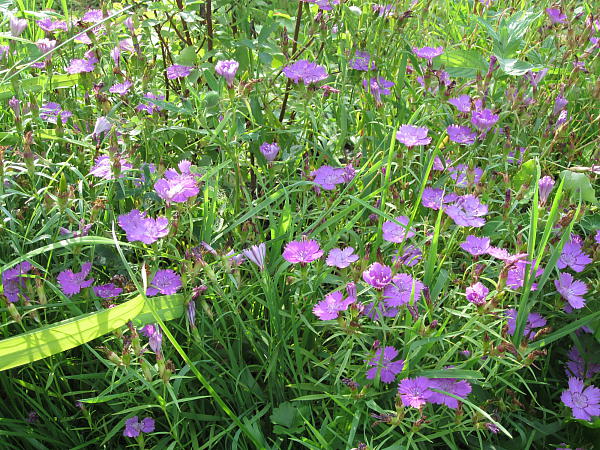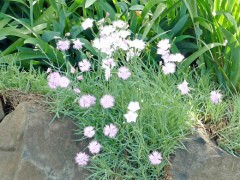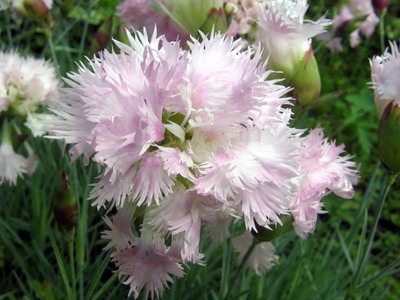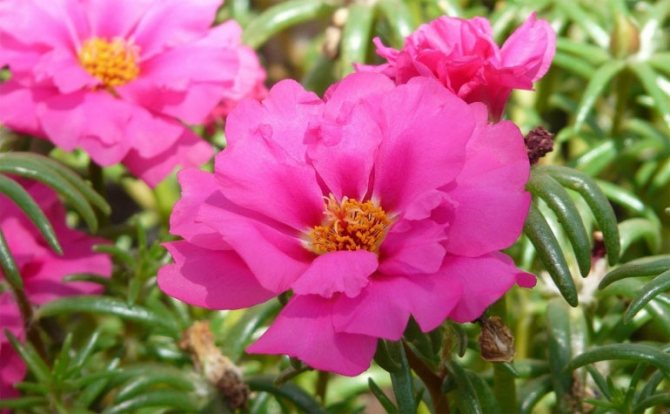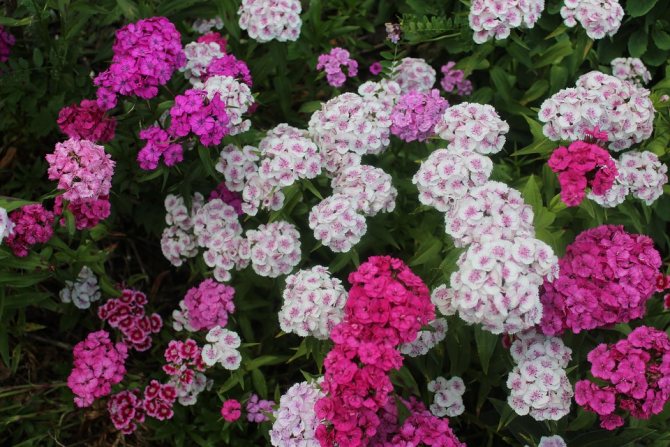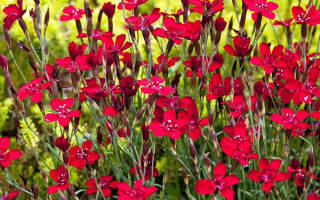The best varieties
For planting in rock gardens and creating low borders, the most interesting are low-growing varieties, reaching a height of 10–20 cm. In mixborders, near decorative deciduous perennials and for decorating rose gardens, larger bushes, as well as creeping forms, are suitable. Two-colored carnations are very cute, as well as flowers decorated with contrasting rings, they invariably become everyone's favorites.
Brilliancy

Carnation herbaceous grade Brilliancy
One of the most popular varieties has absorbed all the best qualities of the species - unpretentiousness, early bright flowering and compactness of the bushes. Plants up to 15–20 cm high, with graceful branching shoots of a bluish color, forming loose clumps. The flowers are small, with shiny crimson-red petals and a burgundy ring towards the center.
The bloom is exceptionally generous, beginning in May-June and lasting until August. Upon completion, it is advisable to remove the peduncles, which will preserve the decorative effect.
Confetti Deep Red

Carnation herbaceous variety Confetti White
A delightful variety of the modern series with dense branched bushes and long colorful flowering. The plants are low, about 15 cm high, covered with dark red, juicy colors, shiny flowers 1–1.5 cm in diameter with a jagged edge.
Abundant flowering, in which each bush becomes a mini-flower bed, begins in May and lasts in waves until the beginning of autumn. The carnation is resistant, in frosty winters it needs light shelter, the ground part does not die off. The Confetti series includes attractive variations:
- Confetti White - with white delicate flowers, decorated with a dark pink thin ring;
- Confetti Deep Rose - lilac-pink with a purple ring;
- Confetti Tiefrot - crimson red with a burgundy ring.
All varieties are suitable for planting in rock gardens, near water bodies or as ground cover plants in poor soils. It goes well with blue fescue bushes and perennial bells. They give good self-seeding.
White Red

Carnation herbaceous variety White Red (White Red)
Flowering plants create a fantasy patterned carpet in pink and white. A wonderful variety is presented in the collection of the "Author's seeds" company. The bushes are low, form dense sods, from which peduncles up to 15 cm in height rise in many. The flowers are small, white with a bright pink or crimson center. The aroma is pleasant, spicy.
Luxurious bloom lasts for two months - from June to early August. An excellent dwarf variety suitable for growing as a groundcover or tapeworm on a rocky hill.
Shrimp

Carnation herbaceous variety Shrimp (Shrimp)
Sprawling branchy bushes grow up to 15–20 cm in height, stems and leaves are green with a bluish bloom, covered with sparse pubescence. The flowers are graceful, with a finely toothed edge, a dense pink "shrimp" color with a thin beard ring.
The catchy variety is interesting as a ground cover plant and for planting in rockeries, looks great among stones, next to chocolate geycher, near conifers. It blooms for a long time - from June to the end of August, abundantly and brightly.
The article "Carnation - the best varieties and hybrids" presents the most popular varieties of different types of carnations.
The choice of the season and site. Planting a carnation
It is advisable to choose a sunny area for it, but in addition to this, it is necessary to pay attention to the soil - non-acidic, fertile and loose. It is best to sow in spring, for example, in March, because by the cold the bushes will have time to get stronger and they will not be afraid of frost
But before winter it is undesirable, since seedlings may die. But this is if you need sowing for seedlings. If the gardener is going to plant seeds directly into the ground, then the optimal month will be May (10-20th day). Reproduction is possible by dividing the root and seeds.
Before you start seedlings, you need to prepare the boxes and soil.They take sand, process it to prevent the occurrence of various diseases, then mix it with peat and sod soil. In this case, the last two components are taken in a ratio of 1 to 1, and a little less sand.
Next, you need to mix everything until smooth, sprinkle on boxes or pots and water. When the seeds are laid out, sprinkle them on top with a small amount of sand and cover with foil. The room temperature should be about 18 degrees before the sprouts appear. After at least 2 appear, it is necessary to move the containers to a room with a temperature of 13 degrees.
Also, the seedlings need good lighting. With its lack, it is impossible to water abundantly and often, one is enough, a maximum of two times every 7 days.
You can preliminarily carry out stratification: put the seeds in the refrigerator for a week until they hatch. After that, they are placed in a warm and well-lit place.
When a couple of leaves appear on the sprouts, you can dive. If the number of leaves reaches 5, the growth point is pinched. In April, when the temperature is above zero, the seedlings dive into separate pots, while the roots cannot be deeply buried. At the same time, it is necessary to start hardening the clove. For this, the plants are taken out into the street, in a place where there are no drafts.
In May, the time comes when you need to plant in open ground. By the way, experienced gardeners do not recommend skipping the sowing stage for seedlings, since the seeds of this ground cover plant are very small, they can be carried away by the wind or killed by a weed. Other experts, on the contrary, believe that sowing should be done immediately in a permanent place because of the thin and delicate taproot.
It is necessary to plant future bushes in open ground at a distance of at least 30 cm.As for whether to sow on seedlings or directly into open ground, everyone should decide on their own - in any case, if you take into account some recommendations, the carnation herb will develop and bloom correctly.
Planting Turkish carnations in open ground with seeds
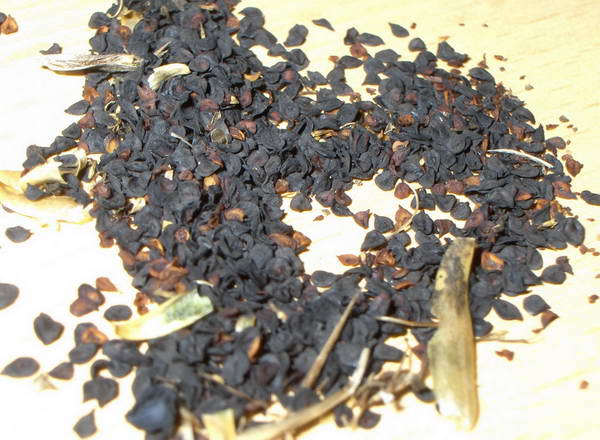
Turkish carnation seeds photo
When to plant Turkish clove seeds? These are completely unpretentious flowers that are not afraid of low temperatures. Therefore, you can safely sow the beauty directly into the ground at the first opportunity to go “into the field”: when the land is ripe, from the end of April.
- Prepare shallow furrows because the seeds are very shallow and should not be buried too deep. Enough and 1 cm.
- Leave the distance between adjacent rows sufficient, do not spare space: you need at least 15-20 cm so that the bushes do not clog each other.
- In a row, 15 cm is also left between the plants, simply breaking through the extra seedlings. You can leave 5-7 cm between the seedlings and when they reach a height of 8-10 cm, simply transplant the extra specimens to another place.
Seeds sprout for a long time, so do not worry: friendly shoots will appear necessarily, after which do not forget to break through them so that there is no strong thickening. Turkish carnations are easily bred with seeds even with the onset of summer, the bushes have time to take shape in order to winter well and please with bright flowering next year.
When sowing in early June on a seedling bed, seeds, as rarely as possible, are laid out along the grooves spilled with water, lightly sprinkled with earth. After the emergence of shoots, care consists in timely watering and weeding from weeds. Well-developed rosettes are formed at the end of summer.
They can be transplanted to another place with a distance of 15-25 cm from each other. If you intend to leave the seedlings where they grew, then you should thin out to the required interval, replanting the excess to another place.
If young plants have released peduncles, then it is better to remove them so that the bushes take root well and do not go weakened before winter. Next year, already with the onset of summer, the Turkish carnation will delight you with lush and abundant flowering.
There is another option for sowing Turkish carnations - dry seeds before winter. Seeds are sown before the onset of persistent cold weather directly on the garden bed without watering. Seedlings will appear with the onset of spring - such plants will bloom a little later.
Site selection and soil preparation
Chinese carnations grow well in sunny areas or in partial shade, and in deep shade they stretch out and practically do not bloom. Soils for planting should be drained, fertile, calcareous or neutral.
The Chinese carnation is moisture-loving; in the southern regions, light loams are preferable for it - too porous sandy loam soils do not retain moisture well.
On the contrary, in the northern regions, carnation grows well on sandy loam, provided that a sufficient amount of organic fertilizers is applied. At the same time, slow heating of the soil can delay the spring planting of seedlings, and it is advisable to choose a site with a slight slope to the south or southwest. In this case, the earth will warm up faster and it will be possible to start planting earlier.
Since the Chinese carnation is grown as an annual flower crop and is planted in the spring, the plot is prepared in the fall. Digging, per 1 sq. m, add a bucket of rotted manure or compost, add 2-3 kg of high-moor peat to improve the structure, and a half-liter can of wood ash as a mineral fertilizer.
It is worth considering that it is unacceptable to plant Chinese carnations in areas with stagnant water, and in no case should fresh manure be introduced into the soil.
They dig up a plot to a depth of 18–20 cm, carefully choosing the roots of perennial weeds - wheatgrass, sow thistle, bluegrass, which can drown out young plants and serve as a forage base for pests.
How to plant in open ground?
Planting Chinese carnations in open ground in the country or near the house implies the correct choice of a site where the plant will grow and develop well. The best choice would be a sunny or slightly shaded place, a lack of light will lead to a stretching of the stem and poor bud formation
It is important that there is no stagnation of moisture in the soil on the site chosen for planting, as this greatly harms the root system. In the northern regions, it is worth taking care that the soil is rather loose - sandy, sandy loam soils are suitable
To prevent the plant from drying out in the south, it is better to plant it on loam.
It is recommended to start preparing land for the formation of a flower garden in advance. Since autumn, the soil is dug up, humus or compost is introduced into it in a volume of 10 liters per 1 m². It will also be useful to use 0.5 liters of wood ash and high moor peat to improve fertile properties. Cultivation of the soil is carried out to a depth of 20 cm, in the process of work, weeds are removed from it.
Seeds are planted in the prepared area in spring, in May or in April, but not earlier than the soil warms up to +15 degrees, and the air - to +20. The seeds are buried 15 mm. To increase germination, it is recommended to pre-soak in a weakly concentrated aqueous solution of copper sulfate or an amber solution.
Before planting, grooves are laid in the ground. The seeds are mixed with agrovermiculite, placed in the soil, then the crops are sprayed from a spray bottle. It will take about 3 weeks to wait for germination. Self-seeding of carnations is possible in regions where there is a moderately cold climate in winter. In severe frosts, seed material will simply not rise in the spring.
It is very important to protect the seedlings of Chinese carnation from negative atmospheric influences. She needs shelter in the form of a mini-greenhouse, film, covering material
The cover is removed only after the seedlings sprout. Next, it is necessary to thin out the plantings, saving them from unnecessarily weak sprouts, the rejected material can be continued to grow in a pot or container.With the appearance of the second leaf, the distance between the plants should be at least 10 cm. After the 5th shoot emerges, a second pick is made, which allows leaving at least 25–30 cm between the plants.
Planting care

Shabo carnation (Dianthus caryophyllus var.shabaud)
Regular watering and feeding, protection from pests and diseases are the main methods of carnation care. In addition, weeds should be removed in time and seedlings should be thinned out during seed reproduction - weak young plants do not develop well in thickened plantings, and with the growth of perennial weeds, they may die altogether.
Watering
Plants are watered in moderation, many perennial species tolerate drought well, slightly losing their decorative effect. At the same time, varietal and hybrid varieties with large double flowers require regular watering - every 7-10 days at the rate of 7-8 liters of water per 1 square meter. m.
The next day after watering, loosening is carried out, destroying the crust, or the soil is mulched with peat or humus 5–7 cm thick in advance. This method will save moisture and improve the structure of the soil.
Fertilizer
Carnation is responsive to fertilizing, fertilized plants have more lush, thicker colored foliage and bloom brighter. A week after planting and at the beginning of flowering, complex fertilizers are applied.
In the first feeding, a composition with equal proportions of the main elements (nitrogen, potassium and phosphorus) or with a slight predominance of nitrogen is used. You can fertilize the flower bed with a mixture of the following composition:
- ammonium nitrate 6 g;
- superphosphate 10 g;
- potassium salt 3 g.
The increased phosphorus content will have a positive effect on the development of the root system. The proposed amount of fertilizer will be enough for feeding 10 sq. m landings. For the same purpose, you can use Kristalon yellow or green
During the budding period, dressings with a low nitrogen content and a high potassium content are used. During the season, it is enough to carry out two dressings. If the Shabo bushes are transplanted into pots in the fall, the plants are fed again in early September.
Disease and pest control

Pinnate carnation (Dianthus plumarius)
Perennial species carnations, if the rules of agricultural technology are observed, mainly in the absence of stagnant water, rarely get sick. During seed propagation at the stage of growing seedlings, varietal and hybrid plants can be sick with fungal and bacterial diseases, less often with viral infections. Of the fungal diseases, the greatest damage is caused by Fusarium, Alternaria and rust.
Fusarium blight manifests itself in the form of drying spots with a brown or black surface and a pinkish bloom on the stems of plants, more often at the root collar. Leaves and peduncles when affected by Fusarium turn pale and wither, and the plant quickly dies. To combat the disease, planting is treated with 0.1–0.2% suspension of foundationol, the same preparation is poured under the root, and the soil around the plants is sprinkled with dry powder.
Alternaria affects leaves and stems, characterized by the appearance of black spots, further drying out and loss of the affected areas. To combat the disease, one of the fungicides is used - copper oxychloride, Ridomil or colloidal sulfur.
When damaged by rust, reddish pustules are formed on the leaves in the form of small tubercles, in which the spores of the fungus develop, spilling out of the pustules as they mature and infecting everything around. Rust sick bushes are destroyed, plantings are treated with Topaz fungicide or copper oxychloride at least two to three times per season. If the lesion is observed in the greenhouse, carry out the same treatments and provide intensive ventilation.
A variety of pests of garden and flower plants - aphids, ticks, caterpillars, bears, wireworms, thrips and others - can also cause damage to plantings. In case of severe damage, pesticides are used - Decis, Bi-58, Arrivo. For treatments, it is advisable to use harmless herbal preparations based on wormwood, hot pepper, onions, garlic and pyrethrum.
So, when attacked by aphids, thrips, planting ticks, they are treated with onion infusion according to the following recipe:
- Take 200 g of chopped hot onions and pour 1 liter of boiled cold water (you can add a handful of onion husks).
- The drug is insisted for 15-16 hours, strained, squeezed and brought to a total volume of 8 liters.
Used for spraying plantings in the evening and morning hours.
How to take care of it properly?
Carnation of the Chinese carnation is carried out taking into account the characteristics of the plant itself. Pinching the top helps to stimulate the growth and abundant branching of the bush. After flowering, all dried stems and buds must be cut off. This work is done with a pruner, with a deviation from the base of the stem about 15 cm. Some time later, the bush will sprout again.
It is imperative to adjust the watering. Normally, it is carried out weekly, in the heat, increasing the frequency up to 2-3 times a week. In case of heavy precipitation, it is not recommended to add moisture. The watering process is carried out exclusively at the root, it is impossible for it to fall on the leaves or buds, which can provoke diseases.
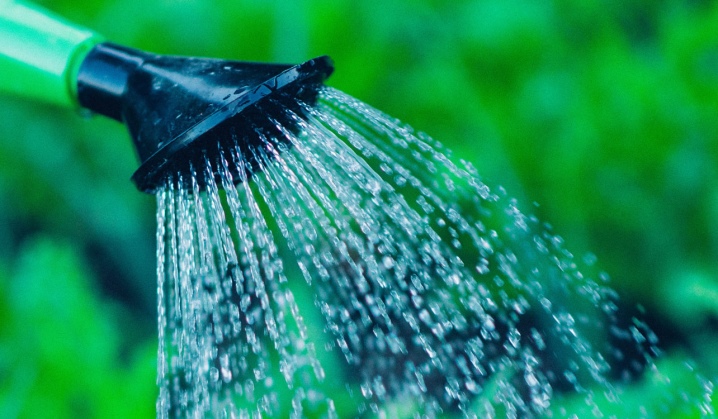
Proper care also affects the flowering intensity. Chinese carnation needs constant maintenance of the required moisture level. Mulching the root area of the plant will help keep the soil fairly moist. Weeding the weeds on a regular basis will also be helpful.
Carnation of the Chinese carnation is also regularly required. The plant needs sufficient amounts of potash fertilizers, complexes of mineral supplements. In addition, it will be beneficial to introduce a substrate that improves root nutrition. It is necessary to fertilize the cloves once every 2-3 weeks.

Wintering of Chinese carnation is normal only in warm climates. In front of it, the perennial is cut almost at the root, leaving no more than 10 cm on top of the soil. Next, the remaining pruning with dry foliage is mulched, the plant is covered with spruce branches. As soon as snow falls, the carnation wintering site is sprinkled with it for additional protection from the cold.
Site and soil selection
In order for the plant to please you with spectacular flowering, healthy appearance and development, you must choose the right place for planting and correctly assess the soil composition. If this is not done, the flower will not receive enough light, nutrition, moisture and will develop poorly. Optimal soil type:
- lightweight, with good air permeability, loose;
- neutral or slightly acidic type;
- containing humus.
Acidic soils are neutralized with lime, ash, and if the soil is heavy, its quality is improved with peat, perlite. For disembarkation, it is best to choose a sunny area where partial shade appears in the afternoon. Too shady areas are not suitable, the leaves will look faded, the abundance of flowering will decrease. If you are planting carnations in pots, pots, containers, you should protect it from direct sunlight. It is necessary to protect mini-carnations from moisture-loving neighbors, otherwise moisture stagnation will form, harmful to flowers.

